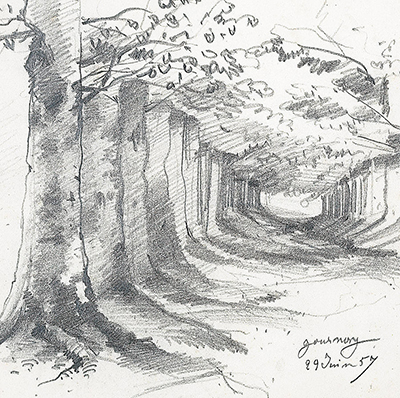Monet was born in 1840, so when he drew Forest Lane at Gournay, he was only around 17 years old. At this point in time, he was producing several drawings of the French coastline. Gournay is in Normandy, but his collection of works from the same year include a view of the harbour at Dieppe, for example.
Whilst many of his drawings combine pencil or graphite sketches with a watercolour wash to add depth and gradients, Forest Lane at Gournay is created simply using a combination of pencil and paper - classic artist's tools.
Forest Lane at Gournay is a sketch that both looks wonderfully modern and very simple. It simply depicts a line of trees, laden with foliage, stretching off into the distance. White space is used to great effect, and the whole impression of Forest Lane at Gournay is one of openness and light.
It is undeniable that this sketch is able to conjure up a sense of the freshness and hopefulness of springtime in the natural world, something that Monet would return to again and again as an adult artist in his oil and pastel and gouache depictions of the countryside of his native France.
Another aspect of Forest Lane at Gournay that instantly strikes the viewer is its immediacy. The clever use of diagonals suggests that the viewer is seeing the eponymous forest lane at eye level, as if they are quite literally standing in the middle of the lane in the artist's place.
Monet's penchant for sketching and painting out of doors in this immediate way was called 'en plein aire' style. This style was characteristic of the French Impressionists, but it was also a key characteristic of a slightly earlier and more realist school of French painting known as the Barbizon School (Barbizon painters were also very interested in the rural French landscape, and indeed they took the name of their school from a little French village known as Barbizon). Related artists include John Singer Sargent and Joseph Mallord Turner.
Like many of Monet's sketches from throughout his life, Forest Lane at Gournay seems to be deliberately left somewhat incomplete. There is a vast expanse of white space at the top of the paper, for example, which has not been pencilled over with foliage or clouds.
Again, this contributes to the open and fresh and bright feeling of the sketch. Even though he did not have any colours at his disposal other than white and grey, and even though he opts for quick hatching in places rather than seamless gradient style shading, in Forest Lane at Gournay Monet manages to conjure up a landscape that is at once almost tangible and very dreamlike. In so doing he achieves one of the key aims of what would be his later, Impressionist, style: imbuing a work of art with vivid emotions.


